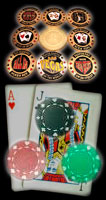Passive Players
A passive poker player doesn’t bet or raise on most hands but will tend to call.
A player who will almost always call and almost never raise is called a “calling station.”
You should avoid being a calling station, but you should look for calling stations at your table.
It’s usually best to have passive players on your left.
Because they don’t raise much, the information value from acting after before the flop is fairly small.
Maniacal Players
A maniac is similar to a player with Fancy Play Syndrome, but a little more extreme.
A player with FPS tends to make bets or raises in an attempt to be tricky, and he does it in situations where it’s probably inappropriate and not to his advantage to do so.
A maniac often raises just because it’s fun. A maniac is not just a loose-aggressive player. He’s much more than that. He’s a loose-aggressive player
with FPS and an itch to gamble. He’s loose in that he plays too many hands; he’s aggressive in that he tends to raise a lot, but he also tends to raise often in inappropriate situations.
He check-raises too much, semi-bluffs too much, and bets marginal draws too much.
The bottom line is that a maniac likes to play and likes to bet. Maniacs seldom fold, seldom call, and raise a lot-at the slightest provocation. It’s best to avoid tables with maniacs if you’re a novice.
If you’re an experienced player, maniacs can be a very important and usually depends on the composition of the rest of the table.
One characteristic of maniacal players is that you can depend on the them to bet or raise with weak hands frequently.
Because of that a maniac is a certain type of loose-aggressive player that is sometimes best of sit four or five seats on either side of you.
This would be case at a table of generally loose players.
When a player has an extreme loose-aggressive style, you can usually count on the probability that they will raise before the flop, and you can often gain a very large advantage by keying your playing tactics on flop to a maniac.
When you sit to the right of a maniac, just raise when you want to be reraised, forcing other players to call two bets cold or to fold.
If you want to trap other players into calling a raise, check and let the maniac bet so you can raise after other players have called his bet.
The ability to manipulate the betting in this way is a huge advantage at a loose table.
Let the maniac do the raising for you when you just call with your better hands, and by all means fold anything marginal.
Try to get rational aggressive poker players on your right, and very loose, very aggressive ones on your left.
Players Who Bluff Too Much
Anytime you have a player who habitually makes the same mistake, such as bluffing too much,you want to be able to encourage them to continue to make the mistake.
If a player bluffs too much, you want to encourage them to bluff.
Nothing encourage a bluff as much as a check.
especially if you’re in a game where the bet size doubles on the river, you want habitual bluffers on your left.
The reason is, of course, you can pick up many extra bets by checking and calling if a habitual bluffer is acting after you.
Drunks
Drunks are almost always loose players: sometimes passive, sometimes aggressive, always loose.
So if you have to play at a table with a drunk, sit on their left, but the best strategy for a table with a drunk is often to just move to another table-don’t play.
They can be counted on to lose their money, but they slow the poker game down to a snail’s pace and tend to be quick to anger-neither of which is good for the game. Avoid drunks, but sit on their left if you can’t.
Pick the Right Table / Picking a Seat / Theories of Poker / Betting Theory: The Odds
A Theory of Starting Hand Value
A Theory of Flop Play: Counting Outs and Evaluating Draws
The Dynamics of Game Conditions / Table Image / Player Stereotypes
Women and Poker / Spread-Limit Games / Double Bet on the End Games / Kill Games
Short-handed Games / Tournaments / No-limit and Pot-Limit Poker



